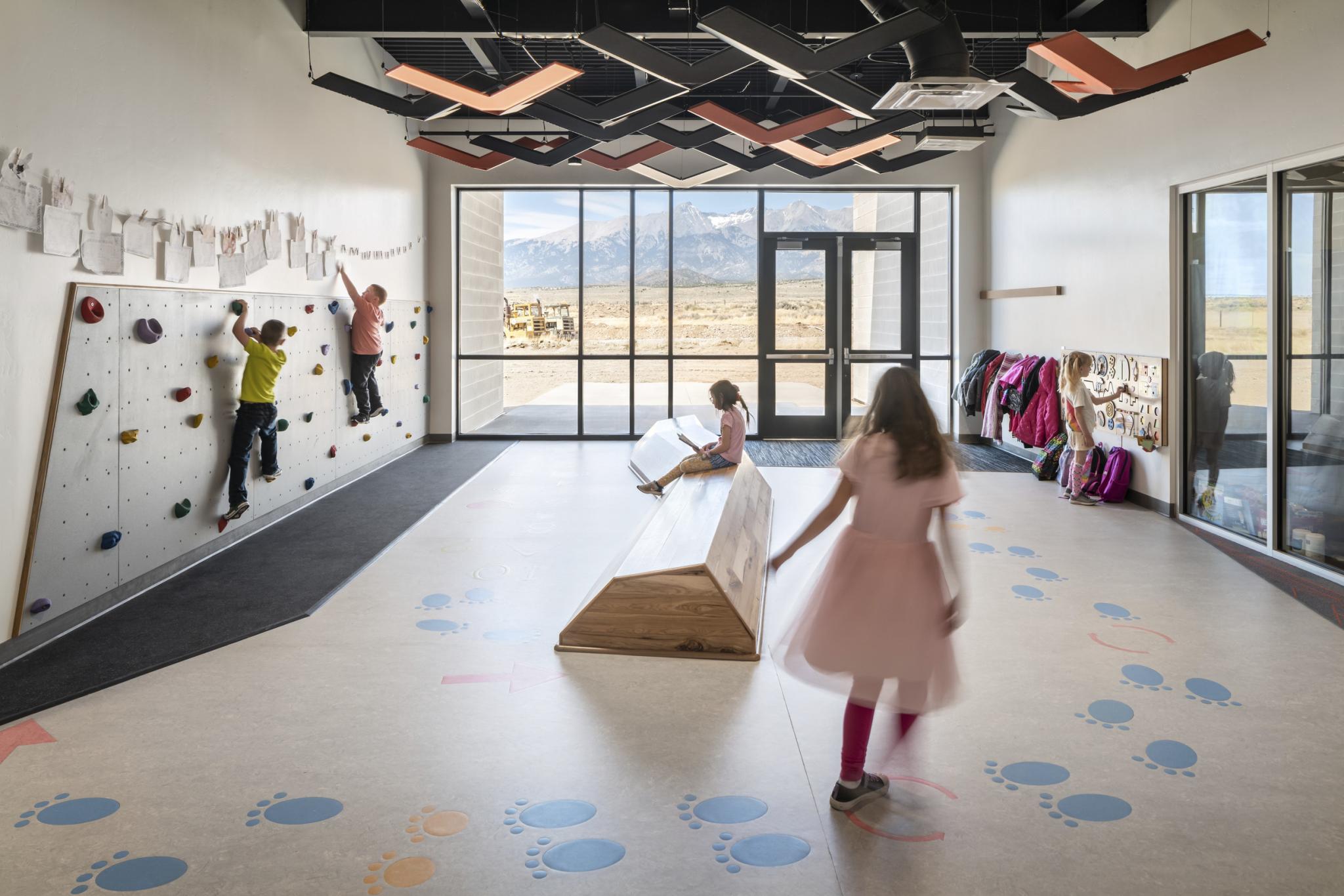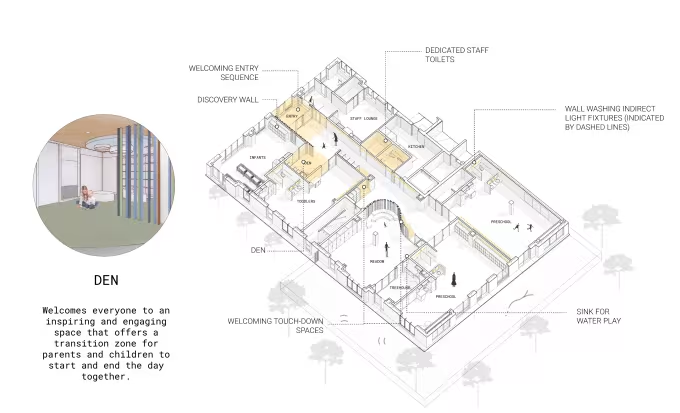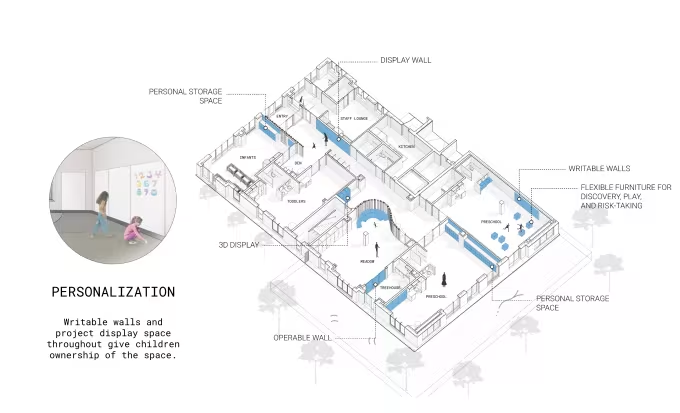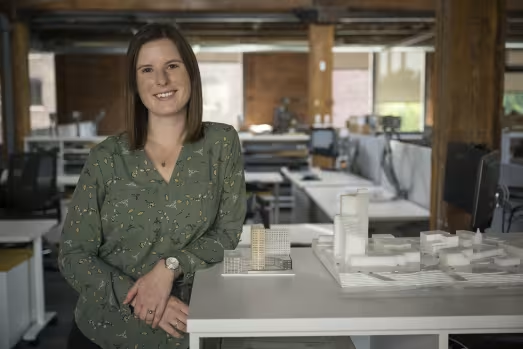Breaking the Trauma Barrier

By: Heidi Neumueller & Hailey Wrasman
According to the April 2024 Minnesota Principal's survey, a staggering 94% of principals agree that student mental health challenges pose a significant barrier to learning. They believe these challenges stem from “student trauma, social media engagement, and the struggles of caregivers.”
At Cuningham, we’re focused on creating design solutions that reduce harm and provide support for students, staff, and their communities. When school environments are safe, nurturing, and responsive to unique contextual challenges, they can reduce negative impacts, helping occupants to recover, learn, and thrive. Rise Early Learning, which recently opened, stands as a testament to how trauma-informed design can transform the learning experience for children, staff, and caregivers.
Located in St. Louis Park, Minnesota, Rise Early Learning is a first-of-its-kind early childhood education facility in the state of Minnesota; the school is a tenant within an affordable housing community, funded by Common Bond Communities and designed by Kaas Wilson Architects. By offering affordable childcare paired with affordable housing and wrap-around services, Rise Early Learning eases the cost burden for its families, making high-quality, affordable childcare available to those who would otherwise not have access.

Cuningham was the design architect for the early childhood education space, helping the client adhere to the project’s three guiding design principles: trauma-informed design, equity, and play. Together, we developed the project vision statement below.
Rise Early Learning Center welcomes all families and teachers to a nurturing, equitable, and fun space. Curiosity and exploration are unbounded as the space is flexible and adaptable to support open-ended play and creativity. Natural, textural, and clean materials provide a backdrop for children's activities, projects, and artwork to shine.
Ahead of Rise Early Learning’s recent grand opening (pictured), we had the chance to visit with students and staff, and it was truly the most calming childcare center we’ve ever been to. One staff member told us that "Rise is nothing like a place I’ve ever worked before," and highlighted the transformative impact of trauma-informed design.
There are two issues that the Governor and I always hear about when we meet with communities: housing and childcare; Rise on 7 is a nation leading model of doing both on the same site and it’s incredible. I can’t think of a project that more embodies how we take care of each other, other than this project.
Peggy Flannagan
Minnesota Lieutenant Governor
Trauma-informed Design
What is trauma-informed design? Simply put, trauma-informed design is a lens to consider the whole person within an ecosystem of a physical space or community. It's about asking questions that prioritize community, safety, empowerment, beauty, dignity, and stress management. In schools specifically, where mental health concerns are rising for both students and teachers, trauma-informed design principles offer a transformative lens to reshape spaces for comfort and well-being. To dive into the specific examples and strategies, check out our previous article “Trauma-Informed Design: Examples and Strategies.”
Assessing an early childhood project through the lens of trauma-informed design
By engaging Rise Early Learning’s community members in co-creative workshops that explored a range of design strategies, Cuningham implemented key design elements that support holistic student, caregiver, and staff wellbeing. These strategies are detailed below.
Beauty and Meaning
Rise Early Leaning fosters beauty and meaning through feature elements in the public areas to spark curiosity and imagination, mirrors and sensory materials at child height, the strategic use of transparency between spaces, a soothing flooring pattern, and by providing ample daylight and views to the outdoors.

Dignity and Self Esteem
Rise Early Learning features spaces where staff can have private time to collect themselves, multiple dedicated staff toilets, wall washing indirect lighting fixtures where there are mirrors and other reflective surfaces, and spaces where parents, staff, and students can interact simultaneously promote dignity and self-esteem. In addition, grab bars in the learning studios provide back support for staff who are bending up and down all day.

Empowerment & Personal Control
Rise Early Learning makes use of design strategies that support empowerment and personal control by giving occupants the ability to personalize their space and their experiences. Display walls provide space for pinning up artwork for all to view and appreciate, and writable and magnetic walls give students ways to express themselves while learning. In addition, flexible furniture allows for discovery, play, and risk taking in support of neurological development.

Security, Privacy & Personal Space
Design strategies that support security, privacy and personal space are seen through the project’s entry sequence with a secure vestibule, quiet spaces for staff as well as students, and dedicated storage and restroom facilities for staff members. Window seats provide an indoor connection to nature while offering a place of refuge in the learning studios.

Sense of Community
A gathering space near the main entry, pin-up areas in public spaces, and visual connections to the exterior are some of the design strategies that promote a sense of community. In addition, the central play space is the heart of the project providing equitable access for all age groups to play and connect with each other throughout the day.

Stress Management
Finally, Rise Early Learning makes use of design strategies that provide stress management by offering areas of heated flooring for students and staff to play and rest (this is important since they spend much of their time on the floor), acoustic wall paneling for sound management, natural light for moderating mood, and ample connections to outdoor play areas designed within the natural landscape. Windows that go all the way down to the floor allow infants and toddlers to see outside while they sit on the floor.
Rise on 7 demonstrates the transformative power to benefit our community by combining affordable housing with affordable childcare.
Deidre Schmidt
CEO, Common Bond Communities
A holistic approach
Trauma-informed design applies to more than just students. As the Minnesota Principal’s survey suggests, supporting teachers and caregivers is key to supporting students. For Rise Early Learning, we focused on supporting the whole ecosystem and we’re excited about the ways in which the design is adapting to provide critical supports to the community. The school has already re-purposed an open storage area to provide a pantry offering free food and supplies to families in need.
In response to the growing importance of trauma-informed design, Cuningham has developed an internal toolkit to guide designers across all our studios. This toolkit not only includes strategies but also how to effectively engage with communities. Stories from principals in the aforementioned survey reaffirm what we've learned: building resilient school communities means prioritizing the human elements of our work. It's about giving students, staff, and families a voice, nurturing genuine connections, and asking, "How can we help support your health and well-being?"
Join us in this journey as we continue to design spaces that support healing, empowerment, and well-being for all. Learn more about Cuningham’s approach to trauma-informed design by downloading the whitepaper below.

